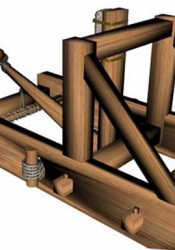The Onager Mangonel Catapult
Developed presumably during the early Roman era from what many believe to be 300 to 400 B.C., the manganon, or the “engine of war,” is what many believe constitutes today’s classification of an ancient catapult. Consisting of a singular launch and block arm, this machine was designed to be pulled to a desired pitch angle from its naturally perpendicular orientation relative to the ground in order to be released to fire a loaded projectile under the properties of torque and angular acceleration. The desired launch angle of the projectile could also be adjusted by placing the block arm horizontally closer or farther from the launch arm when placed at its maximum downward position. Moreover, the mangonel was said to have the capabilities of firing projectiles distances of over 1,000 feet (with a maximum of 1,300 feet), and required less mechanical knowledge to develop, maintain, and operate. According to the ancient Roman historian, Ammianus Marcellinus, these devices were also said to yield significantly greater forces of impact than the previously employed bow and torsion-based catapults. Additionally, according to the ancient Romans, the power and motion of the mangonel catapult mimicked the ferocity of an “onagoras” or “a wild ass,” eventually solidifying the catapult’s full name as the catapult containing the ferocity of wild animals.
Sources:
History of Catapults - Physics of Catapults. (n.d.). Retrieved May 6, 2019, from https://sites.google.com/site/physicsofcatapults/home/history-of-catapults
Yurtoğlu, N. (2018). Http://www.historystudies.net/dergi//birinci-dunya-savasinda-bir-asayis-sorunu-.... History Studies International Journal of History, 10(7), 241-264. doi:10.9737/hist.2018.658

